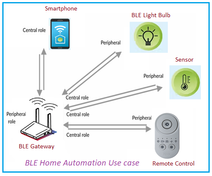7 BLE Advertising Event Types
Learn 7 Bluetooth Low Energy (BLE) advertising event types and their functions.
Showing 25 posts (Page 1 of 2)
Advertisement
Learn 7 Bluetooth Low Energy (BLE) advertising event types and their functions.
Learn LC3 Audio Codec used in Bluetooth LE and explore advantages and disadvantages of LC3.
A comparison of ANT and BLE technologies, highlighting their similarities and key differences in range, power consumption, topology, and applications.
Explore BLE frequency, range, data rate and power consumption as defined in Bluetooth Low Energy (BLE) specifications.

Learn the fundamentals of Bluetooth Low Energy (BLE), a low-power wireless technology used in IoT for short-range communication. Discover its features, topologies, and applications.

Learn about BLE advertising and data channels, their frequency values, and how they facilitate communication between Bluetooth Low Energy devices.

Learn about Bluetooth Low Energy (BLE) advertising and data packet formats according to BLE specifications v4.2 and v5.1, including preamble, access address, PDU, and CRC.
Explore BLE Bonding usage, its benefits and differences with pairing as per Bluetooth Low Energy standard specification.
Learn Broadcaster, Peripheral, Observer and Central role of BLE devices as defined in Bluetooth Low Energy Standard and explore key differences between them.
Explore BLE Channel hopping and its benefits and usage in Bluetooth Low Energy standard specification.
Compare coded PHY vs 1M PHY vs 2M PHY modes used in Bluetooth Low Energy (BLE) and explore difference between them.

Understand the BLE connection process: discovery, connecting (CONNECT_REQ), and connected phases. Learn about master/slave roles, connection intervals, and key BLE states.

BLE Home Automation case study and its GATT design exercise using architecture and components such as bulb, sensor, gateway, remote control and smartphone.

Explore BLE mesh architecture: node roles, routing, and configuration for robust IoT solutions with extended range and reliable connectivity.

Explore the BLE protocol stack and system architecture, detailing each layer's functions from the physical layer to the application layer. Understand how BLE devices communicate and exchange data.
Explore BLE security keys viz. TK, STK, LTK, CSRK and IRK and key differences between them as per BLE specification.
Explore BLE Link Layer States viz. advertising, scanning and connected. Learn key functions and activities of these Bluetooth Low Energy states.

Explore the different states of BLE (Bluetooth Low Energy) devices, including Standby, Advertising, Scanning, Initiating, Connection, and Synchronization.

Compare Bluetooth active vs passive scanning and explore difference between active and passive scanning types.
Learn Bluetooth address types and subtypes viz. public and random (static and private sub-type) including their usage.
Explore 5 key advantages and disadvantages of Bluetooth beacon including its working and application as indoor positioning method.

Explore the differences between Bluetooth Classic and Bluetooth Smart (BLE) specifications, applications, and performance metrics like range, throughput, and power consumption.
Learn 5 key advantages and disadvantages of Bluetooth Low Energy (BLE) audio and its key features.

Explore Bluetooth Low Energy (BLE) technology, including protocols, channels, and differences from classic Bluetooth. Learn how BLE optimizes power efficiency for IoT and wearable applications.

Explore the pros and cons of Bluetooth Low Energy (BLE), covering its low power consumption, suitability for IoT, security features, and limitations in data rates and range.
Advertisement